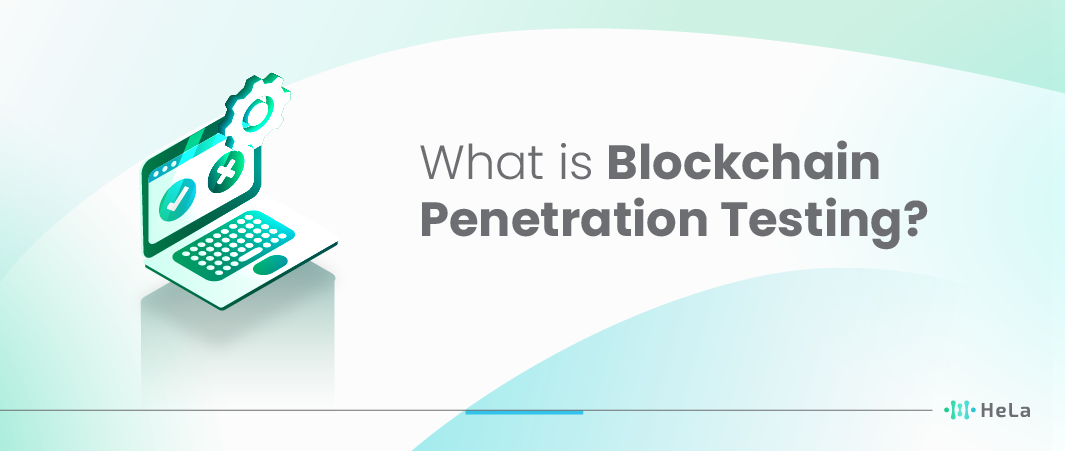Blockchain technology has ushered in a new era of secure and transparent transactions and data management. However, it’s essential to recognize that even this groundbreaking technology is not impervious to potential vulnerabilities and threats. This is where blockchain penetration testing comes into play. In this article, we’ll explore the pivotal methods and strategies for ensuring the security of your blockchain applications.
Blockchain penetration testing, akin to ethical hacking, involves a systematic evaluation of a blockchain system’s security. By simulating real-world attacks, it helps uncover weaknesses in the system’s architecture, smart contracts, and network. As we increasingly rely on blockchain for critical operations, this proactive approach becomes crucial in safeguarding against potential breaches, fraud, and data manipulation. In the following sections, we’ll delve into the fundamental techniques and best practices essential for bolstering the security of your blockchain projects and ensuring their resilience in the ever-evolving digital landscape.
Understanding Blockchain Technology
Blockchain technology is the foundation of many innovative applications and systems, and it plays a pivotal role in various industries beyond cryptocurrency. It operates on a distributed ledger system, meaning that the data is stored and synchronized across multiple nodes (computers) in a network. This decentralized nature offers several key advantages:
Decentralization
Unlike traditional centralized systems, where a single entity or authority has control over data and transactions, blockchain operates on a peer-to-peer network. This means that no single entity has full control, making it resistant to censorship and single points of failure.
Immutability
Once data is recorded on the blockchain, it becomes extremely difficult to alter or delete. This immutability is achieved through cryptographic hashing, where each block contains a reference to the previous block, creating a chain of blocks. Any change in one block would require altering all subsequent blocks, which is computationally infeasible.
Transparency
All transactions on the blockchain are transparent and accessible to anyone in the network. While the identities of users may remain pseudonymous (represented by cryptographic addresses), the transaction history itself is public and can be audited by anyone interested.
Security
Blockchain relies heavily on cryptographic techniques to secure data and transactions. Each transaction is cryptographically signed to prove ownership and authenticity. Additionally, consensus mechanisms such as Proof of Work (PoW) or Proof of Stake (PoS) ensure that malicious actors cannot easily manipulate the system.
Trustless Transactions
Blockchain allows for trustless transactions, meaning that participants can engage in transactions without needing to trust a central authority. Trust is instead established through mathematical and cryptographic principles.
Smart Contracts
Beyond simple transactions, blockchain technology enables the execution of programmable smart contracts. These self-executing contracts automatically enforce the terms and conditions of an agreement when predefined conditions are met.
Efficiency and Cost Savings
By eliminating intermediaries and streamlining processes, blockchain technology has the potential to reduce costs and increase efficiency in various sectors, including finance, supply chain, healthcare, and more.
Global Reach
Blockchain operates on a global scale, making it accessible to users worldwide. It transcends geographical boundaries and can facilitate cross-border transactions and collaborations.
Blockchain technology is a transformative force that offers enhanced security, transparency, and decentralization. Its impact extends far beyond cryptocurrencies, and a solid understanding of its fundamental principles is crucial for identifying and addressing potential vulnerabilities in blockchain-based systems, especially in the context of blockchain penetration testing. This understanding will empower security professionals to assess and enhance the security of blockchain applications and networks effectively.
The Importance of Penetration Testing
In the rapidly evolving landscape of cybersecurity, where threats are becoming increasingly sophisticated, penetration testing holds a paramount position. Penetration testing, often referred to as “pen testing,” is the process of simulating cyberattacks on a system to identify and address weaknesses before malicious actors can exploit them. It is an indispensable practice, and in the context of blockchain technology, its significance cannot be overstated.
Blockchain, known for its decentralized and immutable nature, has gained widespread adoption in various industries, from finance to supply chain management. However, its inherent complexity and the significant value it often holds make it an attractive target for cybercriminals. That’s where penetration testing comes into play, offering several vital advantages:
Identifying Vulnerabilities
Penetration testing thoroughly examines the blockchain network and its associated applications to uncover vulnerabilities. These vulnerabilities may exist in the blockchain’s code, smart contracts, or the network configuration. Identifying these weaknesses before attackers can exploit them is crucial in maintaining the integrity and security of your blockchain.
Proactive Risk Mitigation
Instead of waiting for a breach to occur, penetration testing takes a proactive approach to security. By regularly conducting these tests, you can stay one step ahead of potential threats. This proactive stance allows you to address vulnerabilities and strengthen your defenses before they can be exploited.
Ensuring Compliance
In many industries, regulatory compliance is mandatory. Penetration testing helps organizations demonstrate their commitment to security and compliance by regularly assessing and addressing security risks. This can be especially important in sectors like finance, healthcare, and government, where sensitive data is often managed on blockchain networks.
Protecting Assets and Reputation
A successful cyberattack on a blockchain system can result in significant financial losses and reputational damage. Penetration testing helps prevent these costly incidents by identifying and addressing vulnerabilities that could lead to data breaches, financial theft, or other malicious activities.
Strengthening Trust
Blockchain is built on trust, and its users rely on the technology’s security and immutability. Regularly conducting penetration tests and addressing vulnerabilities enhances the trustworthiness of your blockchain applications, reassuring stakeholders, clients, and users that their data and assets are secure.
Penetration testing is not merely an option but a necessity in the world of blockchain technology. By proactively assessing your blockchain’s vulnerabilities, you can fortify your defenses, protect valuable assets, maintain regulatory compliance, and ensure the trustworthiness of your applications. In an era where cyber threats continue to evolve, penetration testing is an essential tool in the arsenal of any organization utilizing blockchain technology.
Also Read: What are Semi-Fungible Tokens (SFTs)? Opportunities and Challenges
Methodologies for Blockchain Penetration Testing

Blockchain penetration testing is a critical component of ensuring the security and integrity of blockchain networks. This process involves systematically assessing the blockchain’s defenses and identifying potential weaknesses that malicious actors could exploit. Here is a more detailed explanation of each methodology for blockchain penetration testing:
Reconnaissance and Information Gathering
- Begin by gathering information about the blockchain network, such as its architecture, nodes, and participants. This includes identifying the different components that make up the blockchain ecosystem.
- Map out the network topology to understand the flow of data and transactions.
- Enumerate the blockchain’s participants, both internal (nodes, miners, validators) and external (users, developers), and understand their roles and privileges within the network.
- Identify potential entry points and attack surfaces within the blockchain, such as public APIs, web interfaces, and communication channels.
Vulnerability Assessment
- Conduct a comprehensive analysis of the blockchain’s codebase, including both the core protocol and any smart contracts deployed on the network.
- Use automated tools and manual code review techniques to search for known vulnerabilities, such as buffer overflows, injection attacks, and cryptographic weaknesses.
- Examine the blockchain’s configurations to ensure that security settings are correctly implemented. This includes checking cryptographic parameters, firewall rules, and access controls.
- Assess the blockchain’s adherence to best security practices and standards, such as OWASP’s Top Ten Project for web application security.
Permission and Access Control Testing
- Evaluate the access control mechanisms implemented within the blockchain network to verify that they enforce proper authentication and authorization.
- Verify that only authorized users or nodes have access to sensitive functions and data.
- Identify and report any misconfigurations or vulnerabilities related to access control, including privilege escalation issues.
Smart Contract Analysis
- Review the source code of smart contracts deployed on the blockchain for potential security flaws. Pay attention to vulnerabilities like reentrancy attacks, unchecked external calls, and integer overflows/underflows.
- Analyze the logic of smart contracts to identify business logic flaws that could lead to unauthorized access, data leakage, or financial losses.
- Ensure that smart contracts adhere to best practices for secure development, such as using well-audited libraries and following coding standards.
Consensus Mechanism Testing
- Investigate the blockchain’s consensus mechanism, whether it’s Proof of Work (PoW), Proof of Stake (PoS), or another variant.
- Assess the resilience of the consensus algorithm to common attacks like 51% attacks, long-range attacks, and double-spending attacks.
- Evaluate the network’s overall security posture in relation to its consensus mechanism and assess whether it can withstand potential threats or disruptions.
Throughout the penetration testing process, it is essential to document findings, prioritize vulnerabilities based on their severity, and provide actionable recommendations for remediation. Regular and thorough penetration testing helps blockchain networks stay resilient against evolving threats and ensures the security of digital assets and transactions.
Real-World Scenarios and Testing

Real-world scenarios and testing methodologies are critical components of gaining a comprehensive understanding of blockchain penetration testing. This process involves simulating and assessing various attack vectors, including double spending, 51% attacks, and smart contract vulnerabilities, to identify and mitigate potential weaknesses in a blockchain system.
Double Spending Attacks
In a real-world scenario, a double spending attack might involve creating a counterfeit transaction on a blockchain network to spend the same cryptocurrency twice. To test for this vulnerability, penetration testers would attempt to replicate this scenario, examining the system’s response and assessing its security measures to prevent such fraudulent activities.
51% Attacks
In a 51% attack simulation, the testing team would work on gaining control of over 50% of the network’s hashing power. This would enable them to manipulate the blockchain’s transaction history, potentially leading to double spends or the exclusion of certain transactions. Evaluating how the blockchain network responds to such an attack is crucial for enhancing its security.
Smart Contract Vulnerabilities
Smart contracts are susceptible to various vulnerabilities, such as reentrancy attacks, overflow/underflow issues, and logic flaws. In this context, penetration testers would create scenarios where malicious actors exploit these vulnerabilities to compromise a smart contract. By doing so, they can identify weaknesses and recommend improvements or code fixes.
Permissioned vs. Permissionless Blockchains
Real-world testing should also consider the distinction between permissioned and permissionless blockchains. Permissioned blockchains have a limited number of participants, often with known identities, while permissionless blockchains are open to anyone. Testing methodologies should adapt accordingly to reflect the unique security challenges of each type.
Consensus Mechanisms
Different blockchains use various consensus mechanisms like Proof of Work (PoW), Proof of Stake (PoS), or Delegated Proof of Stake (DPoS). Testing should evaluate the resilience of these mechanisms to attacks and potential weaknesses in the chosen consensus protocol.
Network Layer Attacks
In addition to attacks on the blockchain itself, penetration testing should encompass potential network layer vulnerabilities. This includes DDoS attacks, Eclipse attacks, and network partitioning scenarios that could disrupt blockchain operations.
User Authentication and Authorization
Assessing user authentication and authorization systems is essential to verify that only authorized users can access and make changes to the blockchain. Testers may attempt to bypass or compromise these systems to identify vulnerabilities.
Monitoring and Response
Real-world testing should also focus on monitoring and response mechanisms. It’s crucial to test whether the blockchain network can detect and respond to anomalies or attacks in a timely manner, potentially including the use of intrusion detection systems and automated response protocols.
By exploring these real-world scenarios and testing methodologies, organizations can strengthen the security of their blockchain systems, reduce the risk of potential vulnerabilities, and ensure the integrity of their blockchain applications in various operational environments.
Also Read: Layer 1 with Modular Blockchain : Redefining Network Architecture
Continuous Testing and Remediation

Blockchain penetration testing is not a one-time endeavor; it’s an ongoing commitment to maintaining the security of your blockchain applications. In the rapidly evolving landscape of cybersecurity, the static security measures of the past are insufficient. To stay ahead of potential threats and vulnerabilities, organizations must adopt a proactive and dynamic approach to security. This involves establishing a robust continuous testing and remediation process.
Here are some key aspects to consider when implementing continuous testing and remediation for blockchain security:
- Regular Updates: Threats and vulnerabilities in the blockchain ecosystem are constantly evolving. Regularly update your penetration testing strategies to reflect the latest attack vectors, tools, and techniques that malicious actors may employ. Staying current is essential for effectively identifying and mitigating new threats.
- Automated Testing: Implement automated testing tools and processes that can scan your blockchain applications for vulnerabilities on an ongoing basis. These tools can provide real-time feedback, allowing you to address security issues as they arise and reducing the window of exposure to potential attacks.
- Threat Intelligence: Stay informed about the latest threat intelligence in the blockchain space. Monitor industry news, security reports, and advisories to proactively identify emerging threats and vulnerabilities that may affect your specific blockchain implementation.
- Team Training: Invest in training your security team to keep them well-prepared and up-to-date with the latest security practices and incident response procedures. Well-trained personnel are essential for effectively managing security incidents and minimizing potential damage in case of a breach.
- Incident Response Plan: Develop a comprehensive incident response plan that outlines the steps your organization should take in the event of a security breach. Regularly test and refine this plan to ensure that your team can respond promptly and effectively to security incidents.
- Patch Management: Implement a robust patch management process to promptly address vulnerabilities in your blockchain technology stack. This includes keeping blockchain nodes, smart contracts, and associated software up-to-date with security patches.
- Third-Party Assessments: Engage third-party security experts for independent assessments and audits of your blockchain infrastructure and applications. These assessments can provide valuable insights and help identify blind spots that your internal team may overlook.
- Continuous Monitoring: Implement continuous monitoring solutions to keep a close eye on the security posture of your blockchain network. Real-time monitoring can help detect anomalous activities and potential security breaches in their early stages.
- Documentation and Reporting: Maintain detailed records of penetration testing activities, security incidents, and remediation efforts. This documentation not only helps in tracking progress but also aids in compliance and regulatory reporting.
Conclusion
In conclusion, blockchain penetration testing is a vital component of maintaining the security and integrity of blockchain applications. By understanding the technology, following systematic methodologies, and continuously testing for vulnerabilities, you can bolster your defenses against cyber threats. Remember that blockchain security is an ongoing process, and staying vigilant is the key to ensuring the long-term success of your blockchain projects.
Disclaimer: The information provided by HeLa Labs in this article is intended for general informational purposes and does not reflect the company’s opinion. It is not intended as investment advice or recommendations. Readers are strongly advised to conduct their own thorough research and consult with a qualified financial advisor before making any financial decisions.

Joshua Soriano
I am a writer specializing in decentralized systems, digital assets, and Web3 innovation. I develop research-driven explainers, case studies, and thought leadership that connect blockchain infrastructure, smart contract design, and tokenization models to real-world outcomes.
My work focuses on translating complex technical concepts into clear, actionable narratives for builders, businesses, and investors, highlighting transparency, security, and operational efficiency. Each piece blends primary-source research, protocol documentation, and practitioner insights to surface what matters for adoption and risk reduction, helping teams make informed decisions with precise, accessible content.
- Joshua Soriano#molongui-disabled-link
- Joshua Soriano#molongui-disabled-link
- Joshua Soriano#molongui-disabled-link
- Joshua Soriano#molongui-disabled-link

